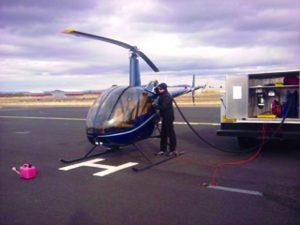Lauren Hamlin
The Broadside

It started with the Wright brothers. Now it has become what one instructor calls a multi-billion dollar industry and you could get started right here on campus.
Central Oregon Community College’s Aviation program offers two options for students wanting a career in aviation. The degree is an Associates of Applied Science with either a helicopter or airplane track. Some students may choose to do both.
The program has over 200 students enrolled, according to John Miller, director of the program. Course work includes combining lectures, visual aids, flight simulators, and real flight training.
“Students go to the college, take classes over there, and then they come to the airport to get more one on one training, plus flight experience,” said D. Jay, a Certified Flight Instructor Instrument Rating (CFII) with Leading Edge Aviation in Bend. “We’ll both have a set of controls then I take them through all the maneuvers and procedures of flying.”
COCC works with Leading Edge Aviation for helicopter flight training and Professional Air for airplane flight training. After students get their certification, they will go on to work as a flight instructor until they have reached 1,500 flight hours. Once they have had 1,500 or more hours of flying, they can work commercially.
Students come out of the program with about 200 hours of flying experience, according to Matt Hagedorn, a former COCC student, and current CFII with Leading Edge Aviation.
Hagedorn graduated from the program in spring term 2011.
“It was a lot of hard work. It takes a lot of dedication,” said Hagedorn. “I’ve always been interested in aviation, so the classes were easy because they had my full attention.”
The Aviation Program was introduced to COCC in 2005 and has grown steadily since. Miller was an instructor at Mt. Hood Community College’s Aviation program before the program was dropped. It was at that time he decided to take flight elsewhere.
“I took all their [MHCC] course material and approached COCC,” said Miller. “We started planning in spring of 2005 and had the first classes in fall 2005.”
The Aviation program’s only initial advertisement was on COCC’s website, so expectations were low.
“The administrators would have been happy with just 10 students,” said Miller. “When the program started, we had 32 students, so they were very pleased, and I was very pleased.”
Jobs in the aviation career field include working for commercial airlines, touring companies, boarder control, working in the military, flight instructing, and more recently, working with Unmanned Aerial Systems (UAS), which are remotely piloted vehicles.
“We’re looking to add Unmanned Aerial Systems (UAS) and a data analysts degree. So over the next couple of years we’re looking to add two new degrees to the program,” said Miller. The UAS world job area is one of the fastest growing in aviation today.”
UAS have been exclusively used in military applications around the world, and are now being recognized as very useful for other applications, according to Hagedorn.
“The Forestry department would like to utililize a UAS,” said Miller “UAS infrared sensors can monitor forest fires controlled from the ground, so what they can do with this is monitor areas a couple times a year and build a model of the forest.”
Programs for certificates in UAS operation have been proposed to COCC.
“If that is successful, then we will add a UAS operator course, and a UAS data analysis course the next (following) year,” said Miller.
With the growing technology, and increase in job potential, Miller hopes to add more to what COCC can offer to students.
“It’s a multi-billion dollar industry, growing by leaps and bounds,” said Miller. “We want Central Oregon to be a part of that.”
(Contact: [email protected])







